Showfoto/Curves Adjust/da: Difference between revisions
Created page with 'I den slags billeder vil vi slette dele af fotoets gråniveau-information og dermed miste detaljer, hvis vi bruger skyderne i niveau-redskabet, og resultatet er ikke godt.' |
Created page with 'Hvad gør vi så? Vi kan bruge redskabet <menuchoice>Farver -> Kurvejustering...</menuchoice>: 20px' |
||
| Line 22: | Line 22: | ||
I den slags billeder vil vi slette dele af fotoets gråniveau-information og dermed miste detaljer, hvis vi bruger skyderne i niveau-redskabet, og resultatet er ikke godt. | I den slags billeder vil vi slette dele af fotoets gråniveau-information og dermed miste detaljer, hvis vi bruger skyderne i niveau-redskabet, og resultatet er ikke godt. | ||
Hvad gør vi så? Vi kan bruge redskabet <menuchoice>Farver -> Kurvejustering...</menuchoice>: [[Image:Adjustcurves.png|20px]] | |||
Selecting this option will show a new popup with a dialog that may look similar to the levels tool. You can see the resulting histogram on top, and the input histogram on the bottom, just like in the levels tool: | Selecting this option will show a new popup with a dialog that may look similar to the levels tool. You can see the resulting histogram on top, and the input histogram on the bottom, just like in the levels tool: | ||
Revision as of 15:32, 21 September 2010
KDE fotointroduktion 1-2 Kurvejustering
Unai Garro (uga) - Sommeren 2008
Dette er anden del af vejledningen i, hvordan man bruger KDE's redskaber til fotografering (nemlig ShowFoto og Krita) til at behandle, redigere og rette fotografier. Den første del af vejledningerne viste, hvordan man forstår et histogram og hvordan man bruger niveau-redskabet. Denne vejledning viser dig, hvordan man bruger et mere avanceret redskab kaldet kurvejustering. Det er meget mere kraftfuldt end niveauredskabet, men det kræver mere tålmodighed og øvelse at opnå et godt resultat.
Lad os komme i gang. Denne gang har vi et foto fra akademy 2008, venligst doneret til denne vejledning af Jos van den Oever.
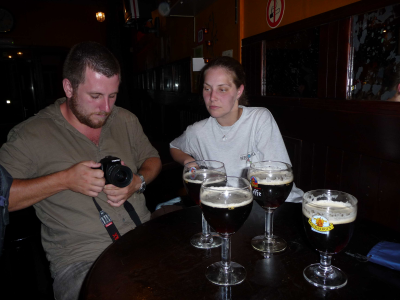
Problemet med dette billede er igen, at dele af det er meget mørke. De to personer er tydelige, men baggrunden er så mørk, at vi faktisk ikke kan se meget af pubben. Lad os se, hvad der sker, hvis vi bruger niveau-redskabet som vi lærte det i den første vejledning:
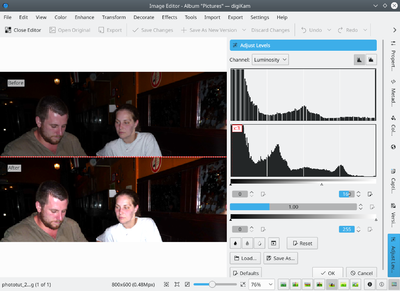
Som du kan se bliver dele af billedet "blæst", når vi bruger niveauredskabet. Det vil sige, at dele af billedet til højre i histogrammet er blevet helt hvide; og det skyldes, at i modsætning til den første vejledning er billedet ikke koncentreret i den venstre del af histogrammet - det spreder sig ud over det hele. Når man så beskærer histogrammet ved hjælp af skyderne, så "spiser" vi dele af informationen.
Dette sker, fordi billedscenen her et meget stor dynamisk omfang, det vil sige, at det både har meget mørke objekter (baggrund) og meget lyse objekter (oplyst med flash).
I den slags billeder vil vi slette dele af fotoets gråniveau-information og dermed miste detaljer, hvis vi bruger skyderne i niveau-redskabet, og resultatet er ikke godt.
Hvad gør vi så? Vi kan bruge redskabet : ![]()
Selecting this option will show a new popup with a dialog that may look similar to the levels tool. You can see the resulting histogram on top, and the input histogram on the bottom, just like in the levels tool:
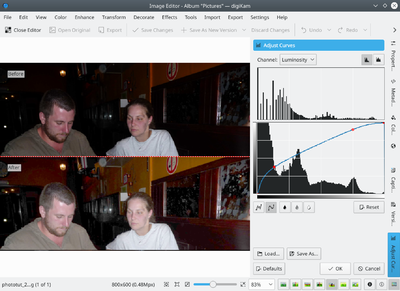
The difference is in the way the control works. In this tool, the input histogram has a diagonal line in it. Clicking on it with the left button of the mouse, adds control points. You can move those control points up or down. The result, as shown in the picture above, is that the gray levels from the horizontal axis are converted into the gray levels in the vertical axis.
Moving the control points up, makes that part of the image brighter. Moving them down, makes that part of the image darker.
In this case, I wanted to make the darkest parts of the image brighter, so I added a control point on the left part of the histogram, and moved the point upwards. As the rest of the image was also getting a bit too bright, I added a second control point to avoid it.
So, lets press OK and see what we get of it:
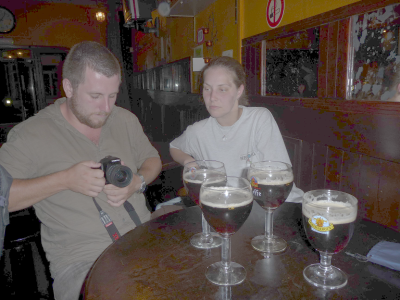
We have managed to make the shadows brighter, and now the pub is more visible, but the image is now a bit washed out. As if it were too bright all over the place. Can we do something? Sure, lets try the levels adjustment again:
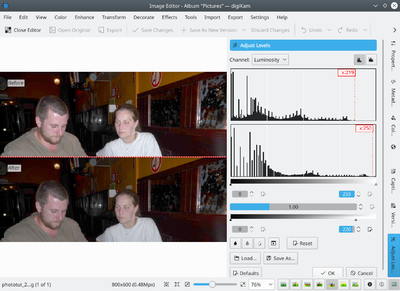
Now that the shadows were adjusted using the curves, and the colors are more uniform, we can follow the method shown in the first tutorial and adjust the levels of the photo, as shown above. The histogram's main data was a bit displaced to the left, and adjusting levels, I made it cover the whole range again.
Lets see the result - Ah, now this is much better. The pub background is much more visible and the two persons are not blown:
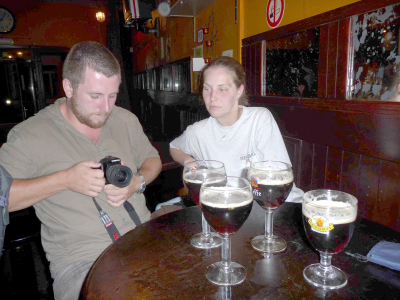
I think that's already acceptable, but if we are picky, the two people are a bit washed out due to the flash light. So, even if that goes out of the scope of this tutorial (it'll be covered in the following tutorials), lets adjust a bit the saturation and contrast in the image for a better result:
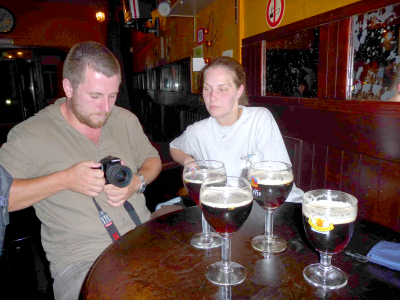
Now this image looks much nicer than the original, yes. I hope you liked this tutorial and will see you in the next one!

